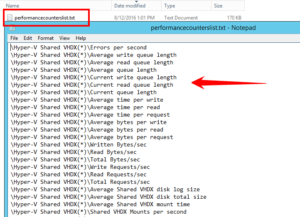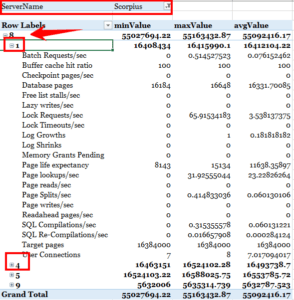How to store performance counters directly on SQL server using TypePerf Command
Introduction
Every DBA should know that the baseline is one of the most important pieces to make a proactive troubleshoot to discover potential problems in your SQL Server environment. The baseline is a key point to measure the instance performance by capturing the data in regular intervals over time to establish a trendline and a pattern of your SQL Server instances. Without a proper baseline, it’s hard to say when and why the problem occurred. You also lose the ability to look over a period and analyze if a problem is really a problem, or if it is a normal environment behavior.Baseline Value
Here is one of the best examples to describe this – A customer opens a ticket informing that the SQL Server is running slow, and he needs to find the root cause of the problem because it’s impacting his business continuity. Before we dig into the investigation, there are some questions that should come to your mind, such as:- Have these issues been reported before?
- Do I have any useful information to guide me into this?
- Do I have a baseline established to verify the performance over a period and find why this came out now?
- Ad-Hoc query that is using all the available resources of the SQL Server machine.
- The developer team that changed a procedure code and now the query plan is causing more CXPACKET usage.
- The SQL Server that is sitting on a virtual machine that is using dynamic memory allocation and because of this is draining the memory.
- The primary site went down, and the DR site doesn’t have the same machine resources than the primary node has.
- The Database Administrator changed the compatibility mode of SQL Server from 2012 to 2014 and the new cost estimator for a particular plan is not behaving accordingly.
- One of the systems started to receive more incoming requests than normal. (i.e. Christmas and Black Friday)
- PAL – Performance Analysis of Log - https://straightpathsql.com/archives/2016/07/create-sql-server-baseline/
- Custom Scripts – DMV’s, DMF’s and Procedures - https://www.sqlskills.com/blogs/erin/sql-server-baselines-series-on-sqlservercentral-com/
TypePerf Command
That’s when the TypePerf command come into play, to help us Database Administrators to store and maintain performance counter information directly to SQL Server. Now there is no more need to save this information on a .xlx file and mark to import using BCP or SSIS or even using RELOG to put together the .blg and then import to SQL Server. Since Windows Server 2008 we have had this command available for use, and to be quite honest I was using an old school solution - too bad for me. A comment about scalability - I tested this solution in some clients, and at this moment I did not see any considerable bottleneck or latency on the capture process. Of course, this depends on your environment and the interval of your collection.Building Solution
First and foremost let’s create the database that will be used to store the performance counter data.- Creating Database Named – PerfMonBaseline
- Creating Views – vw_PerfMonAnalysisByServerperDay and vw_PerfMonAnalysisByserverperMinute
 One of the questions that pop into my mind now is "why do I love this solution?" Simply for the fact that I can collect not only the server that I’m running but that I can extend the collection and start to capture information for all my SQL Server machines by just adding the name of the server and the collector that I want to capture, for example:
\\Scorpius\\SQLServer:General
Statistics\User Connections
\\Scorpius\\SQLServer:Memory
Manager\Memory Grants Pending
\\Scorpius\\System\Processor
Queue Length
\\Serpens\\SQLServer:Buffer
Manager\Buffer cache hit ratio
\\Serpens\\SQLServer:Buffer
Manager\Page lookups/sec Note that I’m capturing information from the instances called
Scorpius and
Serpens. Here is the collector that I’m using in my current solution, file named –
perfcounterssqlserver.txt
\\Scorpius\\SQLServer:Buffer
Manager\Buffer cache hit ratio
\\Scorpius\\SQLServer:Buffer
Manager\Page lookups/sec
\\Scorpius\\SQLServer:Buffer
Manager\Free list stalls/sec
\\Scorpius\\SQLServer:Buffer
Manager\Free pages
\\Scorpius\\SQLServer:Buffer
Manager\Total pages
\\Scorpius\\SQLServer:Buffer
Manager\Target pages
\\Scorpius\\SQLServer:Buffer
Manager\Database pages
\\Scorpius\\SQLServer:Buffer
Manager\Reserved pages
\\Scorpius\\SQLServer:Buffer
Manager\Stolen pages
\\Scorpius\\SQLServer:Buffer
Manager\Lazy writes/sec
\\Scorpius\\SQLServer:Buffer
Manager\Readahead pages/sec
\\Scorpius\\SQLServer:Buffer
Manager\Page reads/sec
\\Scorpius\\SQLServer:Buffer
Manager\Page writes/sec
\\Scorpius\\SQLServer:Buffer
Manager\Checkpoint pages/sec
\\Scorpius\\SQLServer:Buffer
Manager\AWE lookup maps/sec
\\Scorpius\\SQLServer:Buffer
Manager\AWE stolen maps/sec
\\Scorpius\\SQLServer:Buffer
Manager\AWE write maps/sec
\\Scorpius\\SQLServer:Buffer
Manager\AWE unmap calls/sec
\\Scorpius\\SQLServer:Buffer
Manager\AWE unmap pages/sec
\\Scorpius\\SQLServer:Buffer
Manager\Page life expectancy
\\Scorpius\\Memory\Available
MBytes
\\Scorpius\\Paging
File(_Total)\% Usage
\\Scorpius\\PhysicalDisk(*
*)\% Disk Time
\\Scorpius\\PhysicalDisk(*
*)\Avg. Disk Queue Length
\\Scorpius\\PhysicalDisk(*
*)\Avg. Disk sec/Read
\\Scorpius\\PhysicalDisk(*
*)\Avg. Disk sec/Write
\\Scorpius\\PhysicalDisk(*
*)\Disk Reads/sec
\\Scorpius\\PhysicalDisk(*
*)\Disk Writes/sec
\\Scorpius\\Processor(*)\%
Processor Time
\\Scorpius\\SQLServer:General
Statistics\User Connections
\\Scorpius\\SQLServer:Memory
Manager\Memory Grants Pending
\\Scorpius\\System\Processor
Queue Length
\\Serpens\\SQLServer:Buffer
Manager\Buffer cache hit ratio
\\Serpens\\SQLServer:Buffer
Manager\Page lookups/sec
\\Serpens\\SQLServer:Buffer
Manager\Free list stalls/sec
\\Serpens\\SQLServer:Buffer
Manager\Free pages
\\Serpens\\SQLServer:Buffer
Manager\Total pages
\\Serpens\\SQLServer:Buffer
Manager\Target pages
\\Serpens\\SQLServer:Buffer
Manager\Database pages
\\Serpens\\SQLServer:Buffer
Manager\Reserved pages
\\Serpens\\SQLServer:Buffer
Manager\Stolen pages
\\Serpens\\SQLServer:Buffer
Manager\Lazy writes/sec
\\Serpens\\SQLServer:Buffer
Manager\Readahead pages/sec
\\Serpens\\SQLServer:Buffer
Manager\Page reads/sec
\\Serpens\\SQLServer:Buffer
Manager\Page writes/sec
\\Serpens\\SQLServer:Buffer
Manager\Checkpoint pages/sec
\\Serpens\\SQLServer:Buffer
Manager\AWE lookup maps/sec
\\Serpens\\SQLServer:Buffer
Manager\AWE stolen maps/sec
\\Serpens\\SQLServer:Buffer
Manager\AWE write maps/sec
\\Serpens\\SQLServer:Buffer
Manager\AWE unmap calls/sec
\\Serpens\\SQLServer:Buffer
Manager\AWE unmap pages/sec
\\Serpens\\SQLServer:Buffer
Manager\Page life expectancy
\\Serpens\\Memory\Available
MBytes
\\Serpens\\Paging
File(_Total)\% Usage
\\Serpens\\PhysicalDisk(*
*)\% Disk Time
\\Serpens\\PhysicalDisk(*
*)\Avg. Disk Queue Length
\\Serpens\\PhysicalDisk(*
*)\Avg. Disk sec/Read
\\Serpens\\PhysicalDisk(*
*)\Avg. Disk sec/Write
\\Serpens\\PhysicalDisk(*
*)\Disk Reads/sec
\\Serpens\\PhysicalDisk(*
*)\Disk Writes/sec
\\Serpens\\Processor(*)\%
Processor Time
\\Serpens\\SQLServer:General
Statistics\User Connections
\\Serpens\\SQLServer:Memory
Manager\Memory Grants Pending
\\Serpens\\System\Processor
Queue Length
\\Serpens\\SQLServer:SQL
Statistics\Batch Requests/sec
\\Scorpius\\SQLServer:SQL
Statistics\Batch Requests/sec
\\Serpens\\SQLServer:SQL
Statistics\SQL Compilations/sec
\\Scorpius\\SQLServer:SQL
Statistics\SQL Compilations/sec
\\Serpens\\SQLServer:SQL
Statistics\SQL Re-Compilations/sec
\\Scorpius\\SQLServer:SQL
Statistics\SQL Re-Compilations/sec
\\Scorpius\\SQLServer:Buffer
Manager\Page reads/sec
\\Scorpius\\SQLServer:Buffer
Manager\Page writes/sec
\\Scorpius\\SQLServer:Buffer
Manager\Checkpoint pages/sec
\\Scorpius\\SQLServer:Buffer
Manager\Lazy writes/sec
\\Scorpius\\SQLServer:Locks(*)\Lock
Requests/sec
\\Scorpius\\SQLServer:Locks(*)\Lock
Timeouts/sec
\\Scorpius\\SQLServer:Databases(*)\Log
Growths
\\Scorpius\\SQLServer:Databases(*)\Log
Shrinks
\\Scorpius\\SQLServer:Access
Methods\Page Splits/sec
\\Serpens\\SQLServer:Buffer
Manager\Page reads/sec
\\Serpens\\SQLServer:Buffer
Manager\Page writes/sec
\\Serpens\\SQLServer:Buffer
Manager\Checkpoint pages/sec
\\Serpens\\SQLServer:Buffer
Manager\Lazy writes/sec
\\Serpens\\SQLServer:Locks(*)\Lock
Requests/sec
\\Serpens\\SQLServer:Locks(*)\Lock
Timeouts/sec
\\Serpens\\SQLServer:Databases(*)\Log
Growths
\\Serpens\\SQLServer:Databases(*)\Log
Shrinks
\\Serpens\\SQLServer:Access
Methods\Page Splits/sec Now that we have the database, connectivity, and collectors stored in a file, it’s time to test and see if the process is storing the information directly into SQL Server. Before we start the process there are a few options that we need to know to run the command. The
si and
sc parameters are crucial for us and in this case we need to finely adjust to avoid any contention on the server.
One of the questions that pop into my mind now is "why do I love this solution?" Simply for the fact that I can collect not only the server that I’m running but that I can extend the collection and start to capture information for all my SQL Server machines by just adding the name of the server and the collector that I want to capture, for example:
\\Scorpius\\SQLServer:General
Statistics\User Connections
\\Scorpius\\SQLServer:Memory
Manager\Memory Grants Pending
\\Scorpius\\System\Processor
Queue Length
\\Serpens\\SQLServer:Buffer
Manager\Buffer cache hit ratio
\\Serpens\\SQLServer:Buffer
Manager\Page lookups/sec Note that I’m capturing information from the instances called
Scorpius and
Serpens. Here is the collector that I’m using in my current solution, file named –
perfcounterssqlserver.txt
\\Scorpius\\SQLServer:Buffer
Manager\Buffer cache hit ratio
\\Scorpius\\SQLServer:Buffer
Manager\Page lookups/sec
\\Scorpius\\SQLServer:Buffer
Manager\Free list stalls/sec
\\Scorpius\\SQLServer:Buffer
Manager\Free pages
\\Scorpius\\SQLServer:Buffer
Manager\Total pages
\\Scorpius\\SQLServer:Buffer
Manager\Target pages
\\Scorpius\\SQLServer:Buffer
Manager\Database pages
\\Scorpius\\SQLServer:Buffer
Manager\Reserved pages
\\Scorpius\\SQLServer:Buffer
Manager\Stolen pages
\\Scorpius\\SQLServer:Buffer
Manager\Lazy writes/sec
\\Scorpius\\SQLServer:Buffer
Manager\Readahead pages/sec
\\Scorpius\\SQLServer:Buffer
Manager\Page reads/sec
\\Scorpius\\SQLServer:Buffer
Manager\Page writes/sec
\\Scorpius\\SQLServer:Buffer
Manager\Checkpoint pages/sec
\\Scorpius\\SQLServer:Buffer
Manager\AWE lookup maps/sec
\\Scorpius\\SQLServer:Buffer
Manager\AWE stolen maps/sec
\\Scorpius\\SQLServer:Buffer
Manager\AWE write maps/sec
\\Scorpius\\SQLServer:Buffer
Manager\AWE unmap calls/sec
\\Scorpius\\SQLServer:Buffer
Manager\AWE unmap pages/sec
\\Scorpius\\SQLServer:Buffer
Manager\Page life expectancy
\\Scorpius\\Memory\Available
MBytes
\\Scorpius\\Paging
File(_Total)\% Usage
\\Scorpius\\PhysicalDisk(*
*)\% Disk Time
\\Scorpius\\PhysicalDisk(*
*)\Avg. Disk Queue Length
\\Scorpius\\PhysicalDisk(*
*)\Avg. Disk sec/Read
\\Scorpius\\PhysicalDisk(*
*)\Avg. Disk sec/Write
\\Scorpius\\PhysicalDisk(*
*)\Disk Reads/sec
\\Scorpius\\PhysicalDisk(*
*)\Disk Writes/sec
\\Scorpius\\Processor(*)\%
Processor Time
\\Scorpius\\SQLServer:General
Statistics\User Connections
\\Scorpius\\SQLServer:Memory
Manager\Memory Grants Pending
\\Scorpius\\System\Processor
Queue Length
\\Serpens\\SQLServer:Buffer
Manager\Buffer cache hit ratio
\\Serpens\\SQLServer:Buffer
Manager\Page lookups/sec
\\Serpens\\SQLServer:Buffer
Manager\Free list stalls/sec
\\Serpens\\SQLServer:Buffer
Manager\Free pages
\\Serpens\\SQLServer:Buffer
Manager\Total pages
\\Serpens\\SQLServer:Buffer
Manager\Target pages
\\Serpens\\SQLServer:Buffer
Manager\Database pages
\\Serpens\\SQLServer:Buffer
Manager\Reserved pages
\\Serpens\\SQLServer:Buffer
Manager\Stolen pages
\\Serpens\\SQLServer:Buffer
Manager\Lazy writes/sec
\\Serpens\\SQLServer:Buffer
Manager\Readahead pages/sec
\\Serpens\\SQLServer:Buffer
Manager\Page reads/sec
\\Serpens\\SQLServer:Buffer
Manager\Page writes/sec
\\Serpens\\SQLServer:Buffer
Manager\Checkpoint pages/sec
\\Serpens\\SQLServer:Buffer
Manager\AWE lookup maps/sec
\\Serpens\\SQLServer:Buffer
Manager\AWE stolen maps/sec
\\Serpens\\SQLServer:Buffer
Manager\AWE write maps/sec
\\Serpens\\SQLServer:Buffer
Manager\AWE unmap calls/sec
\\Serpens\\SQLServer:Buffer
Manager\AWE unmap pages/sec
\\Serpens\\SQLServer:Buffer
Manager\Page life expectancy
\\Serpens\\Memory\Available
MBytes
\\Serpens\\Paging
File(_Total)\% Usage
\\Serpens\\PhysicalDisk(*
*)\% Disk Time
\\Serpens\\PhysicalDisk(*
*)\Avg. Disk Queue Length
\\Serpens\\PhysicalDisk(*
*)\Avg. Disk sec/Read
\\Serpens\\PhysicalDisk(*
*)\Avg. Disk sec/Write
\\Serpens\\PhysicalDisk(*
*)\Disk Reads/sec
\\Serpens\\PhysicalDisk(*
*)\Disk Writes/sec
\\Serpens\\Processor(*)\%
Processor Time
\\Serpens\\SQLServer:General
Statistics\User Connections
\\Serpens\\SQLServer:Memory
Manager\Memory Grants Pending
\\Serpens\\System\Processor
Queue Length
\\Serpens\\SQLServer:SQL
Statistics\Batch Requests/sec
\\Scorpius\\SQLServer:SQL
Statistics\Batch Requests/sec
\\Serpens\\SQLServer:SQL
Statistics\SQL Compilations/sec
\\Scorpius\\SQLServer:SQL
Statistics\SQL Compilations/sec
\\Serpens\\SQLServer:SQL
Statistics\SQL Re-Compilations/sec
\\Scorpius\\SQLServer:SQL
Statistics\SQL Re-Compilations/sec
\\Scorpius\\SQLServer:Buffer
Manager\Page reads/sec
\\Scorpius\\SQLServer:Buffer
Manager\Page writes/sec
\\Scorpius\\SQLServer:Buffer
Manager\Checkpoint pages/sec
\\Scorpius\\SQLServer:Buffer
Manager\Lazy writes/sec
\\Scorpius\\SQLServer:Locks(*)\Lock
Requests/sec
\\Scorpius\\SQLServer:Locks(*)\Lock
Timeouts/sec
\\Scorpius\\SQLServer:Databases(*)\Log
Growths
\\Scorpius\\SQLServer:Databases(*)\Log
Shrinks
\\Scorpius\\SQLServer:Access
Methods\Page Splits/sec
\\Serpens\\SQLServer:Buffer
Manager\Page reads/sec
\\Serpens\\SQLServer:Buffer
Manager\Page writes/sec
\\Serpens\\SQLServer:Buffer
Manager\Checkpoint pages/sec
\\Serpens\\SQLServer:Buffer
Manager\Lazy writes/sec
\\Serpens\\SQLServer:Locks(*)\Lock
Requests/sec
\\Serpens\\SQLServer:Locks(*)\Lock
Timeouts/sec
\\Serpens\\SQLServer:Databases(*)\Log
Growths
\\Serpens\\SQLServer:Databases(*)\Log
Shrinks
\\Serpens\\SQLServer:Access
Methods\Page Splits/sec Now that we have the database, connectivity, and collectors stored in a file, it’s time to test and see if the process is storing the information directly into SQL Server. Before we start the process there are a few options that we need to know to run the command. The
si and
sc parameters are crucial for us and in this case we need to finely adjust to avoid any contention on the server.
- SI = Sample Interval
- SC = Samples
Testing and Scheduling Daily Run
Open PowerShell ISE and use this command bellow making the adjustments for your environment. [code language="sql"]</pre> TYPEPERF -f SQL -s Serpens -cf "C:\BaseDados\temp\perfcounterssqlserver.txt" -si 60 -sc 720 SQL:PerfMonBaseline!log1 <pre>[/code] -f = SQL Server Type -s = ServerName -cf = Performance Counter File -si = Sample Interval = 60 -sc = Sample Amount = 720 SQL:PerfMonBaseline = Name of ODBC Data Source I would recommend creating two SQL Server Agent Jobs PerfMonRecordSampleData Schedule Time = 08:00 AM Daily [code language="sql"]</pre> TYPEPERF -f SQL -s Serpens -cf "C:\BaseDados\temp\perfcounterssqlserver.txt" -si 60 -sc 720 SQL:PerfMonBaseline!log1 <pre>[/code] Purge – PerfMonBaselineData Schedule Time = 10:00 PM on Sunday [code language="sql"]</pre> DELETE FROM PerfMonBaseline.dbo.CounterData WHERE CONVERT(DATETIME,SUBSTRING(CounterDateTime,0,20)) < DATEADD(HH, -168, GETDATE()) <h3>[/code]Exposing Data
Now that you’ve your own baseline repository containing performance information, you can create an Excel workbook, or create beautiful reports using PowerView, or move this to PowerBI and elevate your analysis to the next level.

